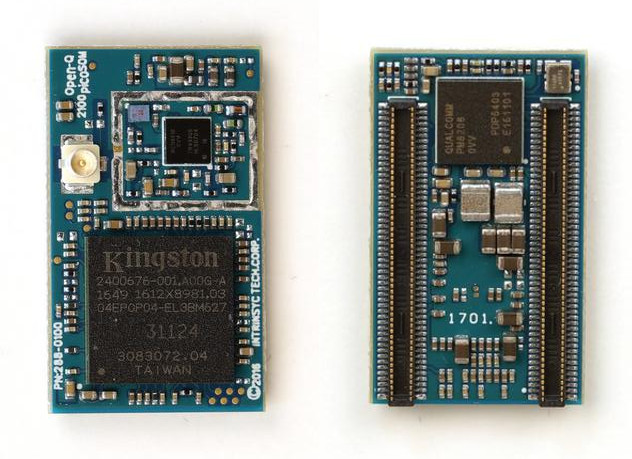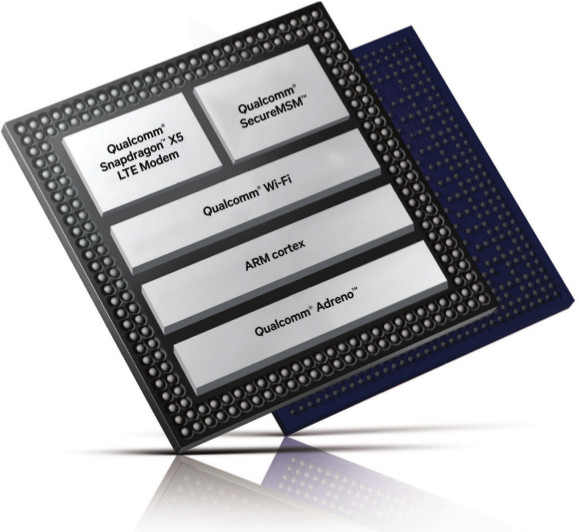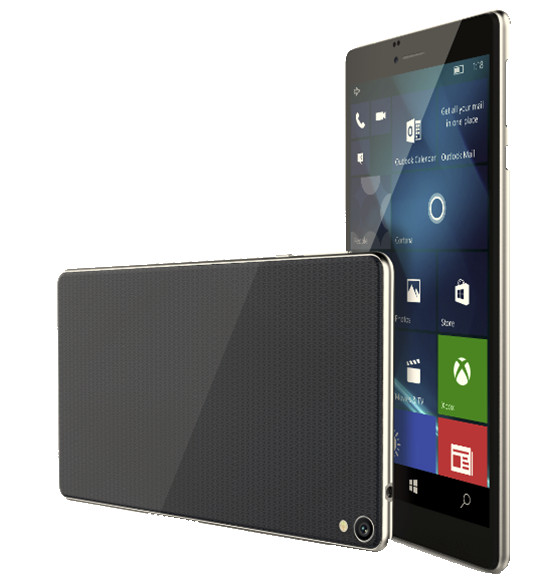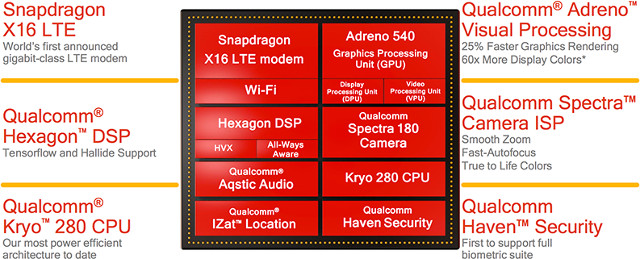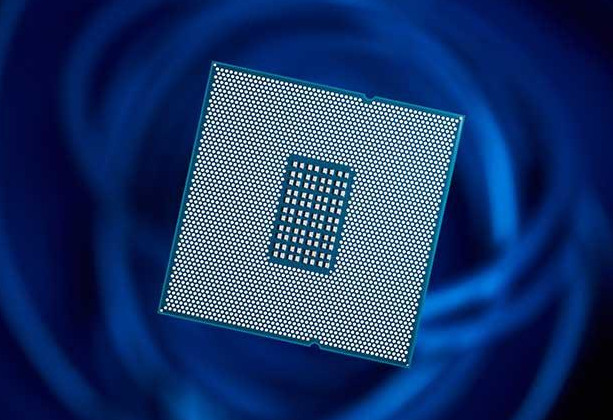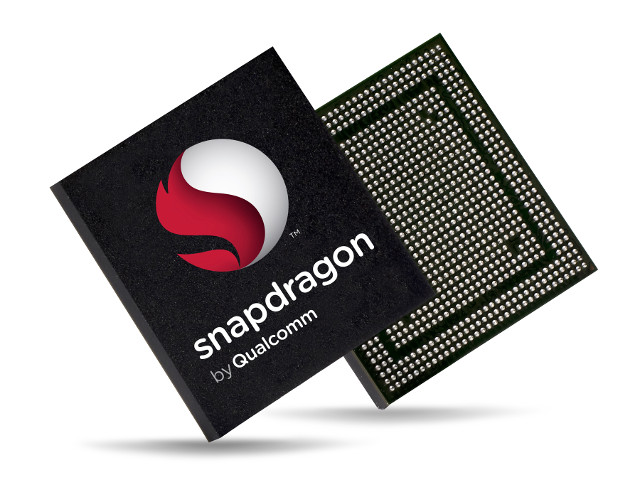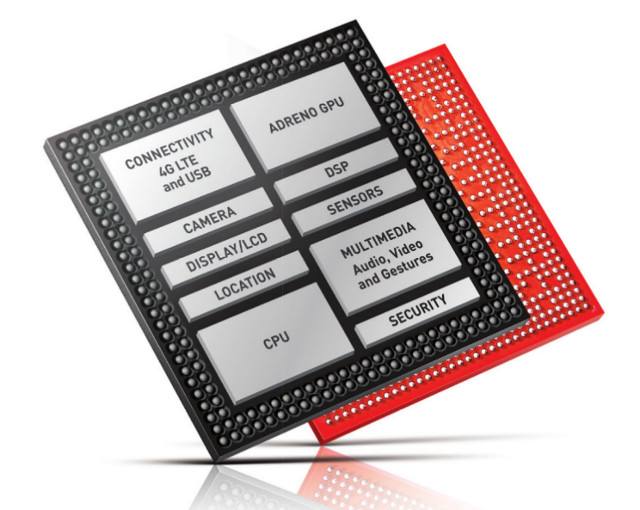Qualcomm unveiled Snapdragon Wear 2100 SoC for wearables early last year, and since then a few smartwatches powered by the processor – such as LG Watch Style and Watch Sport – have been launched, and Intrinsyc has now unveiled one of the first module based on the processor with Open-Q 2100 system-on-module, and a corresponding Nano-ITX baseboard. Open-Q 2100 SoM specifications: SoC – Qualcomm Snapdragon Wear 2100 (APQ8009W) quad core ARM Cortex A7 processor @ up to 1.094 GHz with Adreno 304 GPU System Memory – 512 MB LPDDR3 Storage – 4GB eMMC flash Connectivity – 802.11 b/g/n WiFi (WCN2320), Bluetooth 4.1 LE, Gen 8C GNSS (GPS/GLONASS) with on-board u.FL connector (WGR7640) Audio – Integrated Codec/PMIC (PM8916-1) with optional support for Fluence HD, Snapdragon Voice Activation, and Snapdragon Voice+ 2x 100-pin board-to-board connectors with USB 2.0, I2S, GPIO, MIPI DSI up to 720p @ 60 Hz, 2-lane MIPI CSI, SDC2/microSD […]
Qualcomm 205 SoC is Designed for Entry-level 4G LTE Feature Phones Running Linux
Qualcomm has just introduced Qualcomm 205 “Mobile Platform” designed to bring 4G LTE connectivity and services to entry-level feature phones to emerging regions, such as India, Latin America, and Southeast Asia. The SoC features a dual core ARM CPU, an Adreno 304 GPU, and an LTE Cat 4 modem. Qualcomm 205 SoC specifications CPU – Dual Core ARM Cortex A7 processor at 1.1 GHz GPU – Qualcomm Adreno 304 GPU supporting OpenGL ES 3.0 Memory I/F – LPDDR2 & LPDDR3 up to 384 MHz Storage I/F – eMMC 4.5 flash Display – MIPI DSI up to 480p60 Cellular Connectivity X5 LTE modem supporting LTE Cat 4 with up to 150 Mbps download, 50 Mbps upload; Dual SIM card 2G, 3G and 4G support VoLTE support Connectivity – Support for 802.11 b/g/n & VoWIFI, Bluetooth 4.1, ANT+, FM radio, GPS/GLONASS/Beidou Camera – Dual 3MP camera support (rear + front) up to […]
Emdoor EM-QL8170 is One of the First LTE Tablets Designed Thanks to Allwinner & Qualcomm Partnership
Allwinner and Qualcomm announced a partnership last year to help Chinese manufacturers design entry-level LTE tablets based on Qualcomm Snapdragon processors, and Allwinner collaborated with Emdoor one several designs including EM-QL8170 LTE tablet with a Snapdragon 210 processor and a 6.98″ display. Emdoor EM-QL8170 specifications: SoC – Qualcomm Snapdragon 210 (MSM8909) quad core Cortex A7 processor up to 1.3 GHz with Adreno 304 GPU @ 400 MHz System Memory – 1 or 2 GB DDR3L Storage – 8 or 16 GB flash + micro SD slot Display – 6.98″ IPS touchscreen display with 1280×720 resolution Connectivity – 802.11 b/g/n WiFi, Bluetooth 4.1 LE, and GPS Cellular Connectivity – LTE Cat 4 with 2x micro SIM card slots Camera – 2.0MP front-facing camera, 8.0MP rear camera Audio – 1x microphone, 1x 3.5mm audio jack, likely some speaker somewhere… USB – 1x micro USB port Battery – 2850 mAh battery Dimensions – 189.7 […]
Qualcomm’s Alleged “No License, No Chips” Policy Gets it into Trouble with the FTC
Qualcomm is the leader in baseband processors used for cellular communications in smartphones and other products, and one way the company has become a leader is by leveraging its patents, by either forcing customer to first “purchase a license to standard-essential patents, including elevated royalties that the customer must pay when using a competitor’s processor”, “refusing to license its cellular standard-essential patents to competitors”, or “entering exclusivity dealing arrangements” with companies such as Apple. At least that’s according to a complaint brought by the Federal Trade Commission (FTC) in the US that accuses Qualcomm of maintaining a monopoly and using unfair methods of competition, violating the company’s commitment to license on a FRAND (fair, reasonable and non-discriminatory) basis . The license requirements may explain why smaller companies have a hard time making Qualcomm based products, although this may have improved with the partnership with Allwinner, and the launch of Qualcomm […]
Qualcomm Officially Unveils Snapdragon 835 Octa-core Processor for Smartphones, Mobile PCs, Virtual Reality…
Qualcomm first mentioned Snapdragon 835 processor in November, but at the time, they only disclosed it would be manufactured using 10nm process technology in partnership with Samsung, and claimed the obvious “faster and lower power consumption” compared the previous generation. The company has now provided much more info ahead of CES 2017. Snapdragon 835 key features and specifications: Processor – 8x Kryo 280 cores used into two clusters: performance cluster with 4x cores @ up to 2.45 GHz with 2MB L2 cache efficient cluster with 4x cores @ up to 1.9 GHz with 1MB L2 cache GPU – Adreno 540 GPU with support for OpenGL ES 3.2, OpenCL 2.0 full, Vulkan, DX12 DSP – Hexagon 682 DSP with Hexagon Vector eXtensions and Qualcomm All-Ways Aware technology Memory I/F – dual channel LPDDR4x Storage I/F – UFS2.1 Gear3 2L, SD 3.0 (UHS-I) Display – UltraHD Premium-ready , 4K Ultra HD 60 […]
Qualcomm Starts Sampling of Qualcomm Centriq 2400 ARM Server SoC with Up to 48 ARMv8 Cores
Qualcomm has announced commercial sampling of Qualcomm Centriq 2400 series server SoC built with 10nm FinFET process technology and featuring up to 48 Qualcomm Falkor custom ARMv8 CPU cores “highly optimized to both high performance and power efficiency, and designed to tackle the most common datacenter workloads”. Qualcomm Datacenter Technologies demonstrated the new processor in a Live demo showing Apache, Spark, Java, and Hadoop on Linux running on a SBSA compliant server powered by Qualcomm Centriq 2400 processor, but the company did not provide any further technical details or preliminary benchmark results for the solution. The Qualcomm Centriq 2400 processor series is now sampling to select customers and is expected to be commercially available in H2 2017. That’s about all we know from the press release. However, Linaro have been working on Qualcomm Technologies QDF2432 based board for several months with support for Debian 8.x ‘Jessie’ and CentOS 7 operating […]
Qualcomm Snapdragon 835 Mobile Processor To be Manufactured with Samsung’s 10-nm FinFET Process technology
Qualcomm Technologies and Samsung Electronics have jointly announced that the upcoming Qualcomm Snapdragon 835 processor for mobile devices will be manufactured using Samsung’s 10-nanometer (nm) FinFET process technology. Sadly, neither companies provided further details about the processor itself, but they did offer some insights in the performance and power efficiency improvement between 14nm and 10nm processes with Samsung’s 10nm technology allowing up to a 30% increase in area efficiency with 27% higher performance or up to 40% lower power consumption. Snapdragon 835 is said to be in production now with commercial devices featuring the new processor expected in H1 2017. Jean-Luc Aufranc (CNXSoft)Jean-Luc started CNX Software in 2010 as a part-time endeavor, before quitting his job as a software engineering manager, and starting to write daily news, and reviews full time later in 2011. www.cnx-software.com
Qualcomm Introduces Three New LTE Cat. 7 SoCs with QC 3.0 and Dual Camera Support: Snapdragon 427, 626, and 653
Qualcomm has announced three new Snapdragon 400 & 600 SoCs for entry-level and mid-range LTE smartphones that share Quick Charge 3.0 and dual camera support, as well as an a Snapdragon X9 LTE CAT 7 modem capable of 300Mbps downlink, 150Mbps uplink. Snapdragon 427 Snapdargon 427 quad core Cortex A53 processor is a pin-to-pin compatible update to Snapdragon 425 processor with a faster Cat 7 modem. The Snapdragon 427 is also the first in the Snapdragon 400 family to offer TruSignal antenna tuning for 802.11ac WiFi, includes a 16MP dual ISP, and supports displays up to 1280×800 resolution. You’ll find more details on the product page. Snapdragon 626 Snapdragon 626 octo-core ARM Cortex A53 processor up to 2.2 GHz features a “PC-class” Adreno Adreno 506 GPU, a 24MP dual ISP, also supports TruSignal, 4K @ 30 fps video recording, and displays up to 1920×1200 resolution. It’s a pin-to-pin compatible upgrade […]


